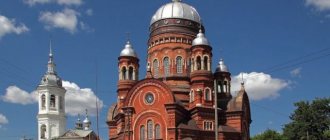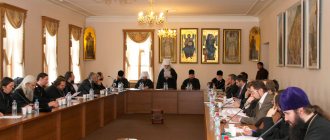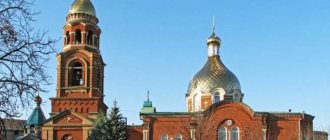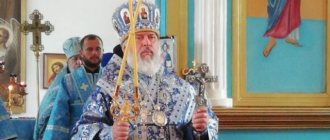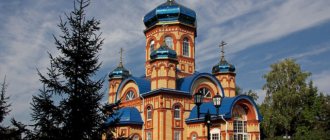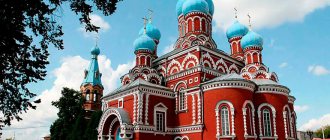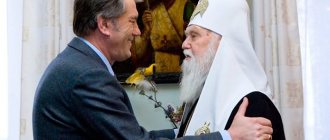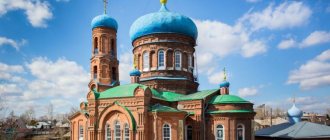| Kharkov Annunciation Cathedral |
Kharkov and Bogodukhovskaya diocese
of the Ukrainian Orthodox Church
- Diocesan administration: Ukraine, 61003, Kharkov, st. Universitetskaya, 8
- Tel.: (57) 712–83–87, 712–83–01, 712–85–23.
- Official site:
- Canonical territory: Kharkov, Bogodukhovsky, Valkovsky, Dergachevsky, Zachepilovsky, Zolochevsky, Kegichevsky, Kolomaksky, Krasnogradsky, Krasnokutsky, Lozovsky, Novovodolazhsky, Pervomaisky, Sakhnovshchinsky districts and cities. Kharkov, Lozovaya, Lyubotin, Pervomaisky Kharkov region.
- Cathedral: Annunciation in Kharkov
- On the map: Yandex.Map, Google map
Since the baptism of Rus', Christianity has strengthened in the lands of the present Kharkov region, which was initially part of the Kyiv diocese, and after its establishment in 1054 - Pereyaslav diocese.
The Mongol-Tatar invasion in the 13th century led to the ruin and devastation of the region and the Pereyaslav See was stopped in 1279. The region was mostly under the rule of nomadic tribes and became the honor of the so-called Wild Field. Only in the century did settlements of Orthodox sedentary peasants appear here again. In the 17th century, the number of Orthodox refugees from the Polish-Lithuanian Commonwealth began to grow, who came here to save from the union imposed by the Roman Catholics, during the years of the liberation war of Hetman Bohdan Khmelnytsky. During these years, the city of Kharkov was founded, and the local region, located on the southwestern border of the Moscow state, received the name Sloboda Ukraine. In the 17th century, the lands of the Slobozhansky Cossack regiments were spiritually part of the patriarchal region, and from 1667 they began to submit to the Belgorod rulers. As part of the Belgorod diocese, Kharkov became an important spiritual and educational center - in 1726, with the active participation of Belgorod Bishop Epiphanius (Tikhorsky), the Kharkov Collegium was opened, also known, by the name of the founder, as the Tikhoretsian Academy - the most significant educational institution in the world after the Kiev-Mohyla Academy southern Russian lands of that time. According to the decree of Emperor Paul I of October 16, 1799 on bringing the diocesan and provincial borders into line, according to the report of the Holy Synod, an independent Sloboda-Ukrainian diocese was separated from the Belgorod diocese, covering the territory of the province of the same name. It included not only the lands of the present Kharkov region, but also the former New Serbia, parts of the Don Military region and others, inhabited by diverse people - mostly suburban Cossacks, but also Moscow “service” people, “beaten serfs”, Don Cossacks, immigrants Greeks and Serbs - Orthodox, but often poorly educated in the faith.
During the 19th century, the number of churches and schools in the diocese increased significantly; in the second half of the century, 14 spiritual and educational publications were published in Kharkov alone. In the 1840-1841 academic year, the Kharkov Collegium was renamed the Kharkov Theological Seminary. In 1866, the Sumy Vicariate was established to help the bishop.
During the years of Soviet power within the USSR, the Church suffered severe trials - the massive closure of churches and all monasteries, the arrests of clergy and active laity, and the confiscation of property did not escape the Kharkov diocese. In addition to the persecution of the atheists, the Church suffered from the schism of the self-sanctified, which sowed confusion among the believing population and was used by the state to exterminate the clergy. As throughout the USSR, persecution subsided only with the advent of World War II, and then resumed in a more covert form in the 1960s. In the early 1970s, there were only 57 parishes in the diocese, most of which did not have church premises.
Only at the end of the 1980s the situation began to change for the better, especially after the celebration of the 1000th anniversary of the Baptism of Rus'. The revival of church life in the diocese and the return of people to the faith have been combined since the early 1990s with a new round of schisms in Ukraine. The Council of Bishops of the Ukrainian Orthodox Church, held in May 1992 in the bishop's residence on the territory of the Kharkov Holy Intercession Monastery and protecting the canonical Church from schism, had historical significance for Orthodoxy in these lands. In 1996, a theological school was opened in Kharkov, which in 1997 was transformed into the Kharkov Theological Seminary.
The diocese covered the entire Kharkov region until May 8, 2012, when the Izyum diocese was separated from its composition, after which the cities of Kharkov, Lozovaya, Lyubotin, Pervomaisky, as well as Kharkov, Barvenkovsky, Bliznyukovsky, Bogodukhovsky, Valkovsky, Zachepilovsky, remained under the jurisdiction of the Kharkov department. Kegichevsky, Kolomaksky, Krasnogradsky, Krasnokutsky, Lozovsky, Novovodolazhsky, Pervomaisky, Sakhnovshchinsky districts in the west of the region.
On July 20, 2012, the Dergachevsky and Zolochevsky districts of the Kharkov region, separated from the Izyum diocese, were assigned to the Kharkov diocese, and the Barvinkovsky and Bliznyukovsky districts of the Kharkov region, separated from the Kharkov diocese, were assigned to the Izyum diocese [1].
Historical names
- Sloboda-Ukrainian and Kharkov (1799 - February 5, 1836)
- Kharkovskaya and Akhtyrskaya (February 5, 1836 - 1946)
- Kharkovskaya and Bogodukhovskaya (since 1946)
Statistics
- 1799 – 673 churches [2].
- 1899 - 930 churches, 816 church schools, 777 church libraries, 16 almshouses [3].
- 1912 - churches - 952, chapels - 75; monasteries - 13 (8 men, 5 women), women's community - 1; theological seminary - 1, theological schools - 3, diocesan women's school - 1, church schools - 816; libraries at churches - 777; hospitals - 7, almshouses - 27 [4].
- January 1, 1958 [5] - 158 registered temples/houses of worship.
- beginning 1970s – 57 parishes [2].
- 2000 - 214 parishes, 3 monasteries [6].
- OK. 2004 - 190 parishes; 155 clergy (147 priests, 8 deacons) [7].
- OK. 2006 - 237 parishes, 3 monasteries (1 men, 2 women) [2].
Bishops
- Christopher (Sulima) (October 16, 1799 - February 6, 1813)
- Apollos (Tereshkevich) (October 14, 1813 - January 20, 1817)
- Pavel (Sabbatovsky) (February 18, 1817 - January 26, 1826)
- Vitaly (Borisov-Zhegachev) (February 28, 1826 - March 12, 1832)
- Innokenty (Alexandrov) (May 19, 1832 - June 22, 1835)
- St. Meletiy (Leontovich) (June 22, 1835 - February 29, 1840)
- Smaragd (Kryzhanovsky) (April 6, 1840 - December 31, 1841)
- St. Innokenty (Borisov) (December 31, 1841 - March 1, 1848)
- Elpidifor (Benediktov) (March 1 - November 6, 1848)
- Filaret (Gumilevsky) (November 6, 1848 - May 2, 1859)
- Macarius (Bulgakov) (April 18, 1859 - December 10, 1868)
- Nektary (Nadezhdin) (January 21, 1869 - September 7, 1874)
- Savva (Tikhomirov) (December 7, 1874 - April 23, 1879) [8]
- Justin (Okhotin) (April 23, 1879 - September 15, 1882) [9]
- Ambrose (Klyucharyov) (September 22, 1882 - September 3, 1901)
- Flavian (Gorodetsky) (November 10, 1901 - February 1, 1903)
- Arseny (Bryantsev) (February 8, 1903 - April 28, 1914) [10]
- Anthony (Khrapovitsky) (May 14, 1914 - May 1, 1917, August 19, 1917 - May 30, 1918) [11]
- Feodor (Lebedev) (? - October 16, 1917) high school bishop. Starobelsky
- Mitrofan (Abramov), high school bishop. Sumy
- Neophyte (Slednikov) (May 30 - November 29, 1918) v/u, ep. Starobelsky
- Georgy (Yaroshevsky) (1919) v/u, archbishop. b. Minsky
1919 - 1921 - widowhood of the department
- Sschmch. Seraphim (Samoilovich) (? - January 15, 1924) high school, bishop. Uglichsky
- Sschmch. Konstantin (Dyakov) (September 21, 1924 - November 12, 1927) v/u, bishop. Sumsky
- Sschmch. Anatoly (Grisyuk) (1934 - 1935) high, metropolitan. Odessa
1938 - 1941 - widowhood of the department
- Panteleimon (Rudyk) (1941) v/u, ep. Lvovsky
1943 - 1945 - widowhood of the department
- Andrey (Sukhenko) (? – November 23, 1960) supreme, archbishop. Chernigovsky
- Alypiy (Khotovitsky) (November 23, 1960 – March 16, 1961) senior, bishop. Kremenchugsky
- Nikodim (Rusnak) (November 23, 1983 - March 28, 1984) v/u, archbishop. Lvovsky
- Onuphry (Easy) (September 16, 2011 - May 8, 2012) v/u, archbishop. Izyumsky
Unbreakable. The Kharkov diocese of the UOC expressed support for the canonical church
Orthodoxy in modern Ukraine. Reference
©
RIA Novosti, Stringer / Go to photo bank
The corresponding statement was made by the press service of the diocese on November 1.
“The assembled clergy, led by the bishop, testified to their loyalty to the canonical Ukrainian Orthodox Church, headed by its primate, His Beatitude Metropolitan Onuphry ,” says the official website of the diocese.
According to the press service, a meeting of the clergy of the Kharkov diocese was held the day before, where issues related to the life of the diocese, preparation for the annual meeting of the clergy, as well as current issues concerning the life of believers of the Orthodox Church in Slobozhanshchyna, a historical region in the north-east of Ukraine and the south, were discussed. -west of the Central Black Earth economic region of Russia.
John of Kherson and Tauride , who stated that he would remain with Onuphry “in any case,” clergy of the Odessa diocese, clergy of the Zaporozhye diocese, as well as bishops and priests of the Dnepropetrovsk, Krivoy Rog and Kamensk dioceses. All of them unanimously opposed the creation of an autocephalous church in Ukraine. They were joined by the Orthodox community of the Church of the Nativity of Christ and St. Nicholas the Wonderworker in Italian Florence, which, in protest against the actions of the Phanar in Ukraine, decided to move from the Patriarchate of Constantinople to the Russian Orthodox Church Abroad (ROCOR).
Tomos of Ukrainian autocephaly: what is it
©
RIA Novosti, Stringer / Go to photobank
In turn, the west and center of Ukraine predominantly support the tomos project.
Thus, according to the results of a study conducted by the sociological group “Rating”, 54% of respondents have a positive attitude towards the idea of creating a “Unified Local Church” (SLC) in Ukraine. In connection with such a division of Orthodox believers, the UOC fears that the tomos could deepen interreligious and civil confrontation in society, as well as lead to violence and attempts to seize holy places on the part of supporters of autocephaly and nationalists.
Political scientist Rostislav Ishchenko in an interview with Ukraina.ru noted that Ukrainian President Petro Poroshenko , provoking a religious conflict, does not understand how it can turn against him and the country as a whole.
“Whether he is issued a tomos or not, Poroshenko will fuel the religious conflict within the country. However, he thinks that he can manage this conflict. In fact, this conflict will destroy Poroshenko, the Ukrainian elite, and the rest of the Ukrainian people,” the expert is convinced.
Kharkov and Bogodukhov diocese
File:Svafanasij.jpg St. Athanasius Patriarch of Constantinople, Lubny Wonderworker
Saint Joasaph Bishop of Belgorod
Orthodoxy appeared on the territory of modern Slobozhanshchina long before the founding of the city of Kharkov[1]. Back in the 11th century, it penetrated here along with the population that converted to Christianity. Influence came from the neighboring principalities - Pereyaslavl and Chernigov, Suzdal and Ryazan, Tmutarakan. In the 12th - first half of the 13th century, this territory was mainly part of the Orthodox Novgorod-Seversky principality. However, the devastating Tatar raids depopulated this land and until the 16th - early 17th centuries the territory remained an almost uninhabited Wild Field.
The beginning of the oppression of the Rusyn Orthodox population of the Polish-Lithuanian Commonwealth by the Poles caused a whole wave of resettlement from the Right Bank and Western Ukraine to the empty lands of Slobozhanshchina, where there were no Poles and religious persecution of Orthodoxy.
Massive popular colonization was preceded by monastic colonization of empty lands. In the Wild Field, monasteries such as Svyatogorsk, Krasnokutsky, Kuryazhsky, Divnogorsky appeared... Settlements arose next to the monasteries. Monasteries attracted settlers not only by the desire to live next to the holy monastery, but also by strong monastery walls, behind which they could hide from Tatar raids.
In the 17th century, Slobozhanshchina was populated by both Great Russians and Orthodox settlers from the Russian, Bratslav and Kyiv voivodeships of the Polish-Lithuanian Commonwealth. They often brought to a new place not only church vessels, liturgical books and other church utensils, but also their church traditions. These traditions differed significantly from North Russian and Moscow customs. This included, for example, the election of clergy and clergy by parishioners, the organization of fraternities, schools and almshouses. The first priests often also came with the settlers.
The population of Slobozhanshchina was multinational from the very beginning; In addition to the Cherkasy settlers, a significant part of the population was made up of Russians - local residents and service people sent by Moscow to help the settlers.
Assumption Cathedral Intercession Cathedral
Spiritual life was at that time one of the most important pages in the life of a migrant, therefore parish churches were among the first to arise in a new place. Thus, the first temple in Kharkov, the Assumption, was built in a year - from 1657 to 1658. And already in 1659 there were 3 churches - Assumption, Annunciation and Trinity. By 1663, 2 more churches appeared - the Nativity and the Church in honor of the Archangel Michael. Temples were built by immigrants.
Most of the temples arose not on the territory of the Kharkov fortress itself, but in settlements. The Kharkov fortress was small in size and could no longer accommodate the entire population who wanted to settle here. Therefore, small settlements - settlements - appear next to the fortress itself. Since they were located not far from the fortress, their population could hide in the fortress itself during the Tatar raid. And the fortress walls did not prevent the population of the settlements from engaging in agriculture and crafts.
The first churches were built of wood and were initially very poor. The poverty of the Assumption Church caused great indignation in the Moscow governor Ofrosimov, who was accustomed to the splendor of churches, which he described in his report to the tsar:
“...But there are no local images and Deesis - the Cherkasy people pray to paper sheets, their Lithuanian letter and walls, but there are no books or factories, and for you, great sovereign, there is nothing to pray to God for; They just lie to God and don’t give a tenth of the praise to God. There is no altar gospel, no service book, no breviary, no Lenten triodion, no trifolo, no apostle, no menaion, no octoechus, no six-day book, no psalter followed, no interpretative gospel. And about this you ordered your merciful decree to be made, so that there would be something for you, great sovereign, to pray to God. And I, seeing their lack of faith, that they worship paper sheets and walls, that’s why I wrote to you. And how you, great sovereign, will indicate"
— Bagaliy D.I. History of Slobidsk Ukraine. — Kharkiv: Osnova, 1990. — P.180-181
The first Kharkov priests were priest Eremeishche, priest Vasilishche and deacon Iosipishche (as they called themselves in their petition to the Moscow Tsar).
The poverty of the first churches forced the clergy to often turn to the king with a request to financially help the new churches and the distressed clergy.
But as the city grew, the prosperity of the churches also increased. In 1685-1687 The first stone church, which has survived to this day, is being built in the city - the Holy Protection Church.
Until 1667, Kharkov church life was under the direct authority of the Patriarch of Moscow and All Rus'; Slobozhanshchina was part of the Patriarchal region; from 1667 to 1799 the territory was part of the Belgorod diocese.
As part of the Belgorod diocese
At this time, church life in Kharkov and the Kharkov regiment was controlled by the Cathedral Archpriest, or spiritual director - the rector of the Assumption Cathedral. In addition to Kharkov, the Kharkov archpriest also had jurisdiction over Valkovsky district and part of Volchansky. His reign was called Protopopia or spiritual court. All bishop's orders that concerned the churches of the Kharkov regiment went specifically to him. Local authorities also turned to Protopop regarding church issues. Other regimental cities in Slobozhanshchina had their own archpriests. In 1744, a Spiritual Board was created in Kharkov, which, in addition to the archpriest, included two more members - a preacher and one learned priest. This reorganization was due to the fact that one archpriest could not cope with all local affairs and often even the smallest matters were sent to the Belgorod Spiritual Consistory, complicating its activities. In 1758, for the 94 churches that were under the jurisdiction of the Kharkov Spiritual Board, there were 3 archpriests, 114 priests, 5 deacons, 62 sextons, and 23 sextons. The entire district of the Spiritual Administration was divided into 5 departments - the Kharkov department (managed by the archpriest), Valkovskoe, Novovodolazhskoe, Olshanskoe and Zolochevskoe governorships, which were led by governors from senior priests. The spiritual administration was the connecting link between the Belgorod Spiritual Consistory and individual parish priests. It also considered some minor cases of its district.
List of Kharkov archpriests:
- Eremey
- Ivan
- Zakharia Filimonovich.
- Pankraty Filimonovich.
- Peter Andreev.
- Yakov Revkovsky 1707-1716.
- Yakov Petrovich Senyutovich 1719-1722
- Grigory Alexandrov 1722-1764
- Stefan Florinsky 1764-1769
- Mikhail Ivanovich Shvansky 1769-1790
- John Andreevich Gilevsky 1790-1795
- Andrey Semenovich Prokopovich since 1795
In 1726, the Kharkov Collegium was founded. At one time, the famous Little Russian philosopher G. S. Skovoroda taught there. On February 26 (March 8), 1764, the Manifesto on the secularization of church property was proclaimed, according to which the monastery lands were transferred to the ownership of the state [2]. In 1786-1788. Secularization was carried out in the southern provinces of Russia and Ukraine. At this time, many monasteries were disbanded.
Gaining independence and the further history of the diocese
On October 16 (29), 1799, by decree of the All-Russian Emperor Paul I, the Sloboda-Ukrainian diocese was formed, separated from the previously huge Belgorod diocese.
Its first bishop was Christopher (Sulima) with the title “Sloboda-Ukrainian and Kharkov”; from February 13, 1836 to June 5, 1945, the title was “Kharkov and Akhtyrsky”; and from June 5, 1945 - “Kharkovsky and Bogodukhovsky”.
Saint Meletios, Archbishop of Kharkov
In 1866, the Sumy Vicariate was established in the diocese.
In the 17th-18th centuries, the main temple of the city was the Holy Assumption Cathedral. After the founding of an independent diocese, the Intercession Cathedral became the cathedral, and the Assumption Cathedral was transformed into the “city cathedral”. In 1846, by synodal decree, the bishop's department was moved from Pokrovsky to the Assumption Cathedral. The Annunciation Church began to be called the “City Cathedral”, and from 1863 - the Resurrection Church. In 1865, the Synod discovered that the title “City Cathedral” was completely unnecessary and the right to be called a cathedral remained only with the Holy Dormition Church.
In 1800, a Spiritual Consistory was opened on the territory of the Holy Protection Monastery. In 1841, the implementation of a new statute for the Spiritual Consistories began, which unified church administration at the diocese level. The diocese was divided into church districts - protopopias, which corresponded to counties and were governed by archpriests and spiritual boards - corresponding collegial bodies. Protopopii were divided into dean districts, and those into parishes. Over time, the institution of protopopia weakened, and in 1840 it was liquidated.
In the 1840/41 academic year, a Theological Seminary was organized in Kharkov on the basis of the former Collegium.
By the time the diocese was founded in Kharkov, there were 10 churches: Pokrovskaya, Uspenskaya, Nikolaevskaya, Blagoveshchenskaya, Dmitrievskaya, Rozhdestvenskaya, Resurrection, Mikhailovskaya, Voznesenskaya and Mironositskaya, which was a cemetery.
If in 1799 there were 673 churches in the diocese, then 100 years later there were more than 1000 of them. At the beginning of the 20th century, there were about 800 parochial schools and about 20 monasteries in the Kharkov region. In total in the Kharkov region in 1904 there were 950 churches, 10 monasteries, 1360 priests and deacons. There were 42 churches in the city itself. In 1912, there were 952 churches, 75 chapels in the Diocese; 13 monasteries (8 men’s and 5 women’s), 1 women’s community; theological seminary, 3 theological schools, diocesan women's school, 816 church schools; 777 libraries at churches; 7 hospitals and 27 almshouses.
On October 16, 1843, based on the report of the Chief Prosecutor of the Holy Synod, Emperor Nikolai Pavlovich approved the request of the residents of Kharkov to introduce a religious procession to transfer the icon of the Ozeryanskaya Mother of God from the Kuryazhsky Monastery to the Kharkov Intercession Cathedral. Processions of the cross were to take place on September 30 (from Kuryazh to Kharkov) and April 22 (from Kharkov to Kuryazh) in accordance with the patronal holidays of the Kharkov Intercession Cathedral (October 1) and the Kuryazh Monastery (April 23). It became the city's main spiritual holiday.
In 1821-1841. The construction of the bell tower of the Assumption Cathedral (89.5 m) was underway, which was higher in height than the bell tower of Ivan the Great in Moscow.
In the second half of the 19th century, 14 spiritual and educational publications were published in Kharkov, in particular the philosophical and theological magazine “Faith and Reason”, the magazines “Spiritual Messenger”, “Spiritual Diary”, “Blagovest”, the newspaper “Kharkov Diocesan Gazette”, and other publications .
Kharkov diocese in the 20th century
From May 14, 1914 to April 1917 (elected again in August of the same year), the Kharkov see was occupied by Anthony (Khrapovitsky), later the first primate of the Russian Orthodox Church Outside of Russia.
Hieromartyr Onuphry (Gagalyuk) Hieromartyr Alexander (Petrovsky) Hieromartyr Konstantin (Dyakov)
In the 1920s, the church life of the Kharkov region was dominated by the “renovationist” movement of the Russian Church. Party and state bodies made efforts to completely eliminate the Patriarchal Church (“Tikhonism”); The Izvestia newspaper of April 18, 1923 reported: “<...> These days, the elimination of the last remnants of Tikhonshchina among the Kharkov clergy has been completed. As a result, 16 priests, led by Bishop Pavel, and 2 Black Hundreds - Stetsenko and Gubiev - were arrested. Black Hundred priests will be expelled from Ukraine.”[3]
In October - December 1923, a Renovation Council was held in Kharkov, which proclaimed the formation of the Ukrainian Orthodox Autocephalous Church (UPAC) and elected a Synod (hence the second name - “synodals”), headed by Metropolitan Pimen (Pegov). In the early 1930s, an acute conflict arose between the UAOC and the Renovation Synod in Moscow; On December 20, 1934, the Moscow Renovation Synod decided to liquidate the UAOC and transfer its parishes to its direct subordination.
From November 11 to November 15, 1924, the All-Ukrainian Pre-Conciliar Conference (“Renovationist”), consisting of 78 delegates: diocesan and vicar bishops and one clergy and layman from each diocese, met in Kharkov. The Central Renovation Synod was represented by Metropolitan Seraphim (Ruzhentsov); Metropolitan Pimen (Pegov) presided. The main issues on the agenda of the Meeting were: autocephaly of the Ukrainian Church and the Ukrainization of worship. The meeting condemned the “self-saints-Lipkovites” as heretics and schismatics. Based on the report of the renovationist Kyiv Metropolitan Innokenty (Pustynsky), a resolution was adopted on the need to transfer the Kiev Pechersk Lavra to the jurisdiction of the All-Ukrainian Holy Synod, which happened on December 15, 1924. From 1924 to the mid-1930s, Kharkov was the center of the Lubensky schism (Buldovo).
During the same period, representatives of the monarchist community of “Podgornovtsy” (named after priest Vasily Podgorny) were active - first under the jurisdiction of Bishop Varlaam (Lazarenko), and from March 1928 - Bishop Alexy (Buy) [4]). At the end of the 1920s, Kharkov was also one of the hotbeds of Josephiteism, headed by Bishop Pavel (Kratirov).
By 1941, there was only one open parish left - the Kazan Church in Kharkov on Lysaya Gora. In 1937-1938 (before his arrest), the episcopal see was occupied by Archbishop Alexander (Petrovsky) (Moscow Patriarchate), who served in the only Orthodox church in the city.
After the occupation of the city by German troops in October 1941, church life began to revive under the leadership of the former leader of Lubentsy, Metropolitan Theophilus Buldovsky, who in the summer of 1942 joined the UAOC (Polikarpovites); There were about 400 parishes under its jurisdiction[5].
In 1946, the Annunciation Cathedral became the cathedral of the Kharkov diocese (Moscow Patriarchate).
In 1947, the relics of St. were transferred from the Intercession Monastery in Kharkov. Meletius and the relics of St. Athanasius (Petellarius), the Wonderworker of Lubensk, located in the museum - to the Annunciation Cathedral of the city.
A sharp reduction in the number of parishes has been observed since the late 1950s: churches were turned into clubs, cinemas, warehouses and other economic institutions. The number of parishes as of January 1, 1979 was reduced to 65, of which 11 remained in Kharkov.
By the year of the millennium of the Baptism of Rus' in Kharkov, the restoration of the Assumption Cathedral was completed; The process of returning churches and monasteries to the diocese began.
Bishops' Council of the UOC 1992
Main article: Kharkov Cathedral
The Council of Bishops of the Ukrainian Orthodox Church that took place on May 28, 1992 in Kharkov, at the bishop’s residence on the territory of the Intercession Monastery, was of fateful significance for the history of the UOC-MP. At the Council, a new primate of the UOC within the Moscow Patriarchate was elected, Metropolitan of Kiev and All Ukraine Vladimir (Sabodan). The council was convened by Metropolitan Nikodim (Rusnak) of Kharkov and Bogodukhov, who presided over it.
The bishops who participated in the Council expressed distrust of the subsequently anathematized Metropolitan Philaret (Denisenko), who did not appear at the Council, and released him from the Kyiv See and the post of First Hierarch of the UOC.
1990s - 2010s
Metropolitan of Kharkov and Bogodukhov Nikodim (Rusnak)
On September 18, 1993, a two-year Theological School was opened in the city of Kharkov, which was approved by the Holy Synod of the UOC on October 19, 1993. And already on September 12, 1996, the Kharkov Theological School received the status of a Seminary. The duration of study was increased by two years. Metropolitan Nicodemus of Kharkov and Bogodukhov became the rector of the Seminary. The first graduation from the Seminary took place on May 21, 1997, when the first 26 people received diplomas from this educational institution.
In 1994, the newspaper “Kharkov Diocesan Gazette” began publishing again, which became the official organ of the Kharkov Diocese, and in 2000 the publication of the philosophical and religious magazine “Faith and Reason” was resumed.
On June 22, 1993, at a meeting of the Holy Synod of the UOC, all the new martyrs of the Sloboda region who suffered during the years of the Bolshevik persecution of the church were ranked among the locally revered saints. Among them are the hieromartyr Archbishop of Kharkov Alexander (Petrovsky), the temporary administrator of the Kharkov Diocese in the difficult 30s, Archbishop Onufriy (Gagalyuk), Metropolitan Konstantin (Dyakov), Archbishop Innokenty (Letyaev), Archbishop Innokenty (Tikhonov), clergy, and other Orthodox devotees.
The return and construction of new churches is actively underway.
On May 8, 2012, by the decision of the Synod of the UOC, the Izyum and Kupyansk diocese was separated from the Kharkov diocese, consisting of 13 districts of the Kharkov region. Kharkov and 14 districts remained within the Kharkov diocese.[6].
Map of the diocese as of July 20, 2012
On July 20, 2012, by the decision of the Holy Synod of the UOC, the boundaries were changed: the Kharkov diocese included the Dergachiv and Zolochevsky districts of the Kharkov region, which were part of the Izyum diocese from May 8 to July 20, as the closest to Kharkov; At the same time, the Barvenkovsky and Bliznyukovsky districts of the Kharkov region, which were previously part of the Kharkov diocese, were assigned to the Izyum diocese as the furthest from Kharkov.
